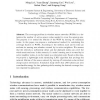Free Online Productivity Tools
i2Speak
i2Symbol
i2OCR
iTex2Img
iWeb2Print
iWeb2Shot
i2Type
iPdf2Split
iPdf2Merge
i2Bopomofo
i2Arabic
i2Style
i2Image
i2PDF
iLatex2Rtf
Sci2ools
UIC
2007
Springer
2007
Springer
A Lightweight Scheme for Node Scheduling in Wireless Sensor Networks
Abstract. The coverage problem in wireless sensor networks (WSNs) is to determine the number of active sensor nodes needed to cover the sensing area. The purpose is to extend the lifetime of the WSN by turning off redundant nodes. In this paper, we propose a mathematical method for calculating the coverage fraction in WSNs. According to the method, each active node can evaluate its sensing area whether covered by its active neighbors. We assume that the network is sufficiently dense and the deployed nodes can cover the whole monitored area. In this scenario, if a node’s sensing area is covered by its active neighbor nodes, it can be treated as a redundant node. Based on this idea, we propose a lightweight node scheduling (LNS) algorithm that prolongs the network lifetime of the sensor network by turning off redundant nodes without using location information. Simulation study shows that LNS scheme can save considerable energy for data gathering while meeting the desired coverage fract...
| Added | 09 Jun 2010 |
| Updated | 09 Jun 2010 |
| Type | Conference |
| Year | 2007 |
| Where | UIC |
| Authors | Ming Liu, Yuan Zheng, Jiannong Cao, Wei Lou, Guihai Chen, Hai-gang Gong |
Comments (0)

